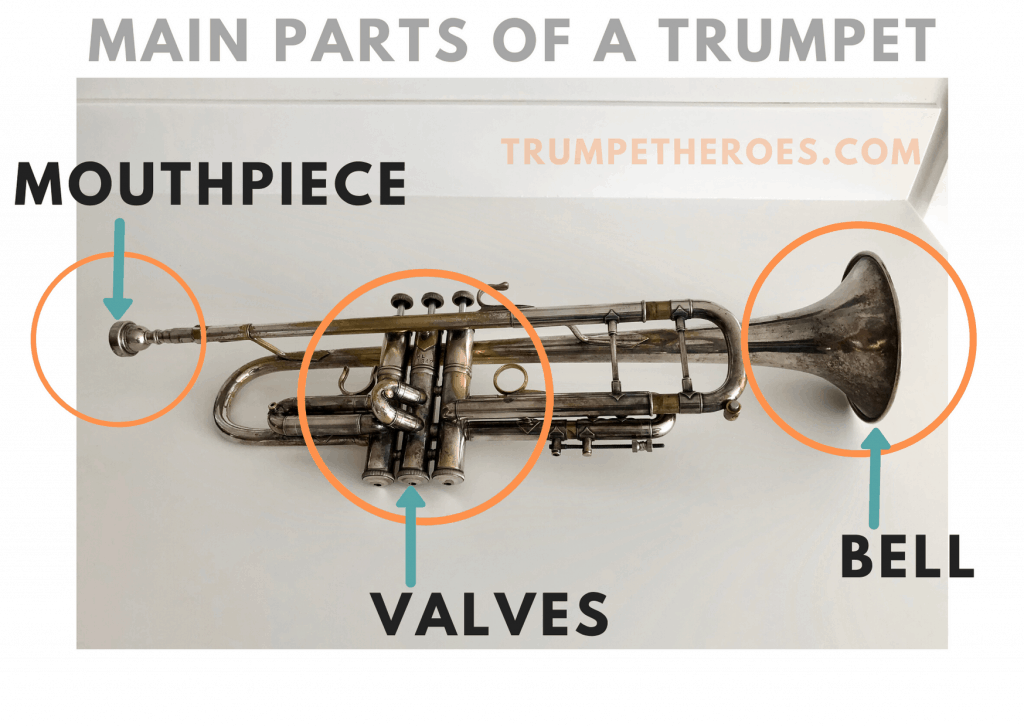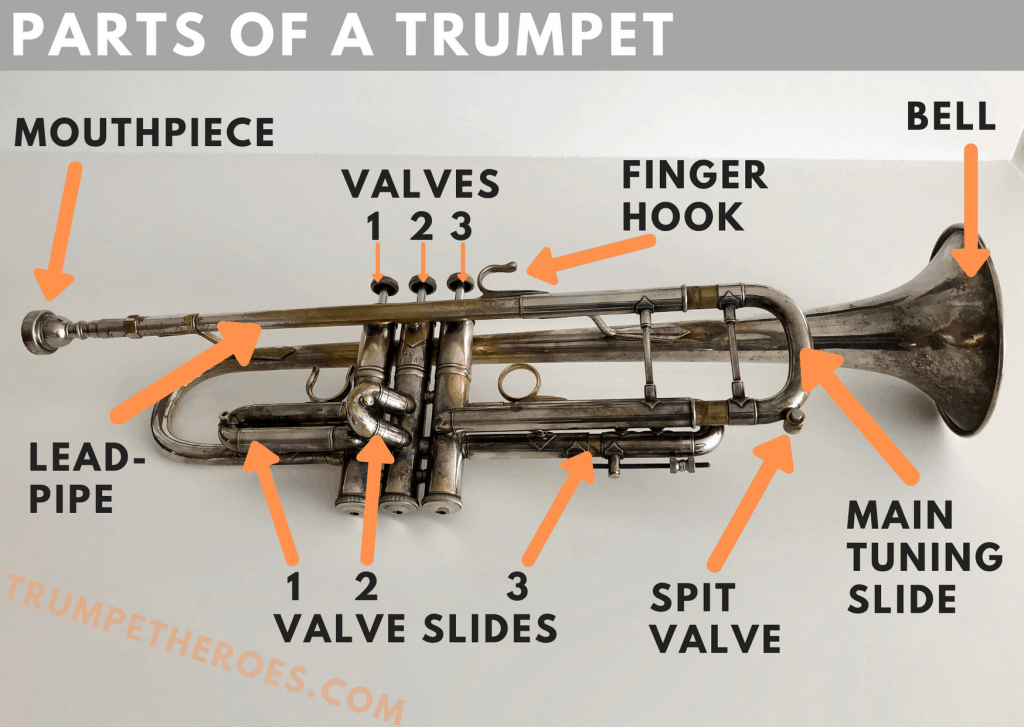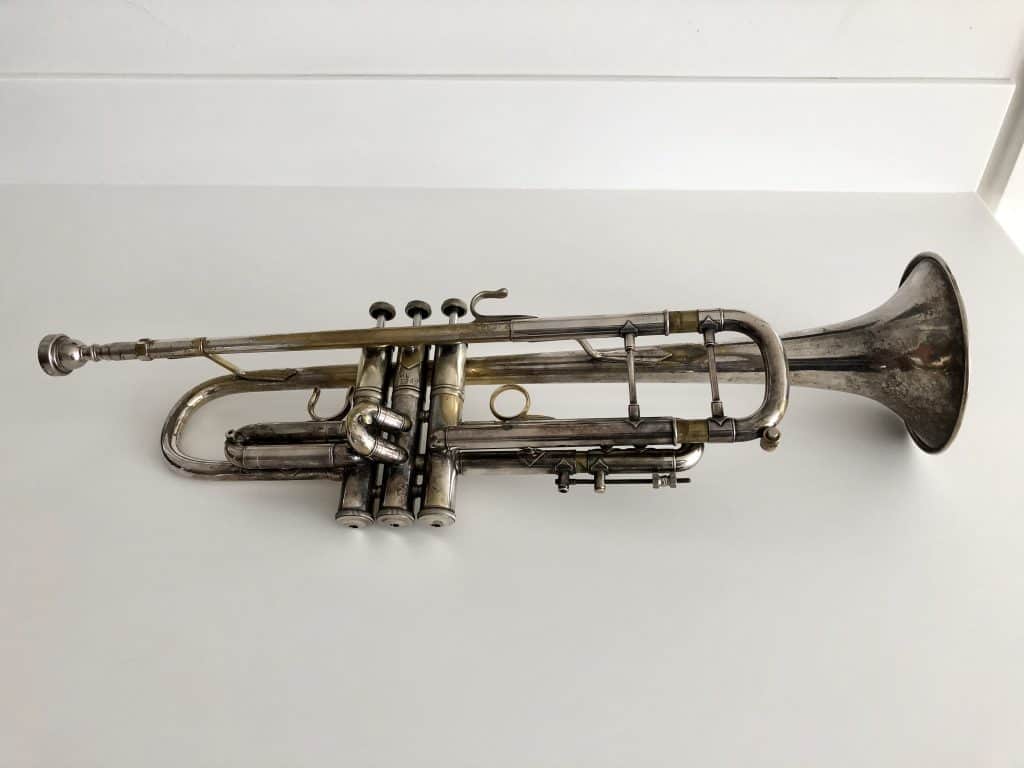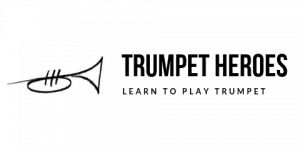This article lists trumpet part names, shows which names refer to which parts, and provides a description of each part of the trumpet. Here are the most basic parts of a trumpet:
- Mouthpiece
- Valves
- Bell
While these are the main major parts of a trumpet, there are lots of little details and finicky parts to learn while you’re learning trumpet! Read on to learn all about the parts of a trumpet.

Trumpet Parts: The Basics
The Mouthpiece is typically a separate, small part that goes in its own place in the case when you’re not playing. It goes into the small end, the Leadpipe (pronounced LEED-pipe) of the Trumpet. The mouthpiece is placed on the player’s lips which then vibrate in the wind created by blowing. The Trumpet amplifies and refines that sound.
The Valves are pushed down and let up by the middle 3 fingers of the right hand and are numbered 1, 2 and 3 starting at the mouthpiece end. Each combination of up and down valves makes a different group of notes available to the player.
The Bell is the flared out wide end of the Trumpet that makes it sound louder and better. The bell gives the Trumpet its distinctive tone and even the smallest variation in size, thickness, alloy, flare, bracing, finish etc. can affect its tonal qualities. The same can be said of the other parts but it’s way easier to get a fight started over bells.
Now let’s get into the details.
Trumpet Parts Diagram
This photo is labelled to show where the separate parts of the trumpet are located:

Parts of a Trumpet: More Detail
Here’s what those other parts do:
The three valves are used to lengthen the effective length if the instrument. Think of the Trumpet as a Bugle. A Bugle is only able to play a handful of different notes. What the valves do is enable the player to access those notes and the ones of Bugles that are a little longer, a little more longer etc etc.
There are 7 different lengths that the valves enable. (If you’re ahead of me and think it’s 8 lengths you should know that the 3rd valve adds the same length as both of the first 2 valves; so it’s 7.) Close inspection will show you that the extra tubing attached to each valve is a different length.
Someone decided a long time ago that the second valve should be the one with the shortest tube – probably because it wouldn’t stick out so far. As a result what we have is a second valve that adds one semitone’s length of tubing; a first valve that adds a whole tone’s worth of tubing and a third valve that adds a tone and a half. Plenty of beginning Trumpet players have no idea that’s going on. They just push down the valves that their teacher tells them to push, blow hard and hope for the best.
Virtually all Trumpets have a ring or trigger attached to the third valve slide. The left hand ring finger generally goes into that ring so that the slide it’s attached to can be moved out for a couple of notes that really need that (there might be some gizmo that keeps that slide from falling out as well). Intermediate and Professional Trumpets will have a similar ring, saddle or trigger on the first valve slide for the same reason.
There is a finger hook attached to the leadpipe that helps with holding the Trumpet, but which many teachers recommend not be used while playing to avoid excess mouthpiece pressure on the player’s lips.
The leadpipe is firmly attached to the valve cluster and bell but the next part of the tubing is free to move. That piece is the Main Tuning Slide and is adjusted regularly to ensure that the player is (mostly) in tune with whatever group or accompaniment they’re playing with.
On the tuning slide, and probably also on the third valve slide is something that is generally labelled as a “Water Key” and referred to by real people as a spit valve. It allows the player to get rid of condensation droplets that collect on the inside of the tubing. This condensation is the result of warm, moist air from the player hitting the relatively cool brass tube. It’s a bit like distillation but, given that all kinds of food and saliva go into your mouth, is probably not very clean or even sanitary. To get this stuff out just hold the lever open and blow gently.
btw. If you needed the ring on the 3rd valve slide to be labelled as the 3rd Valve Slide Ring etc. you’ve had your head down too long. It’s time for a break.

A Few Final Words About Trumpet Parts
Trumpets are made mostly of Brass. They use brass because it’s easy to bend. It will bend nicely into a trumpet if you know how to do that. It will also bend nicely into the shape of anything you drop on it or anything you drop it onto. If you don’t believe me, but you’re willing to concede that Trumpets and Trombones are made of pretty much the same stuff, look here. … or watch one get made at Bach or Yamaha.
The mouthpiece is cut out of a block of brass then plated – usually with silver. The rest of the horn is made mostly of brass but there is some fancy stuff like Monel in the valves. The Valve cluster is brazed or baked in a kind of kiln and everything else gets soldered onto it. The Bell is shaped from a sheet of brass. All of this stuff is delicate and easily damaged.
Most Trumpets are polished really well in the factory then sprayed with a clear, durable finish. Some trumpets skip the lacquer and get electroplated with silver or perhaps nickel/chrome. There are even some that go from the silver plate vat into the gold plate vat. I’ve never owned one.
The Real list of Trumpet parts:
would be way too long and tedious to tackle here. The Bach video here says there are over 120 bits and pieces put together in 465 steps. I’m sure that some corners are cut making cheaper horns, but there’s still gonna be a pile of parts.
I took apart a valve on another post just for fun.
